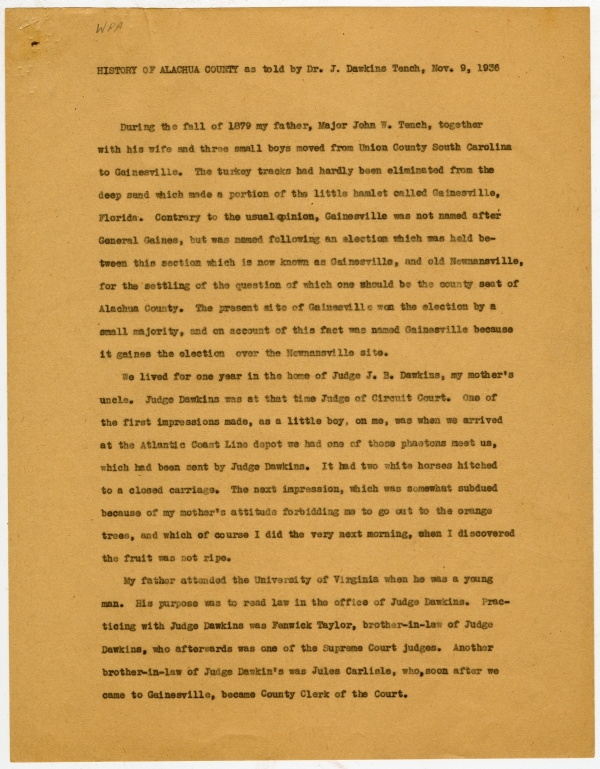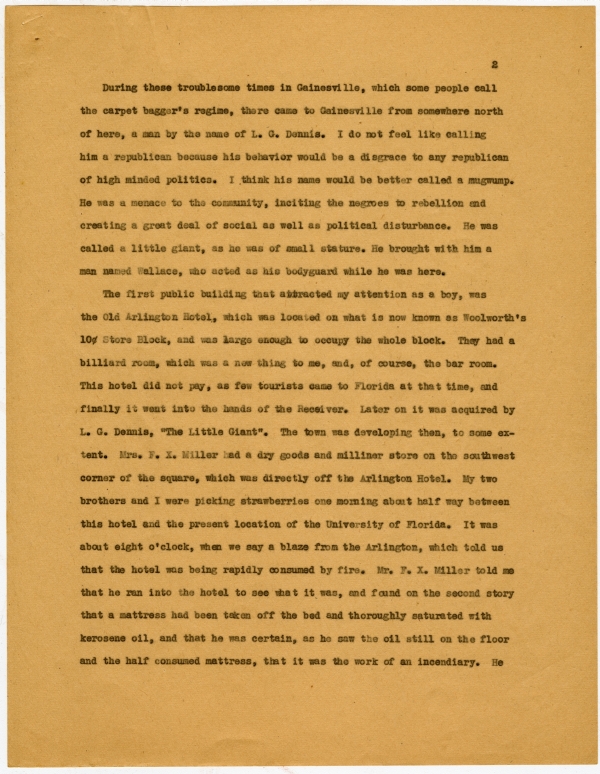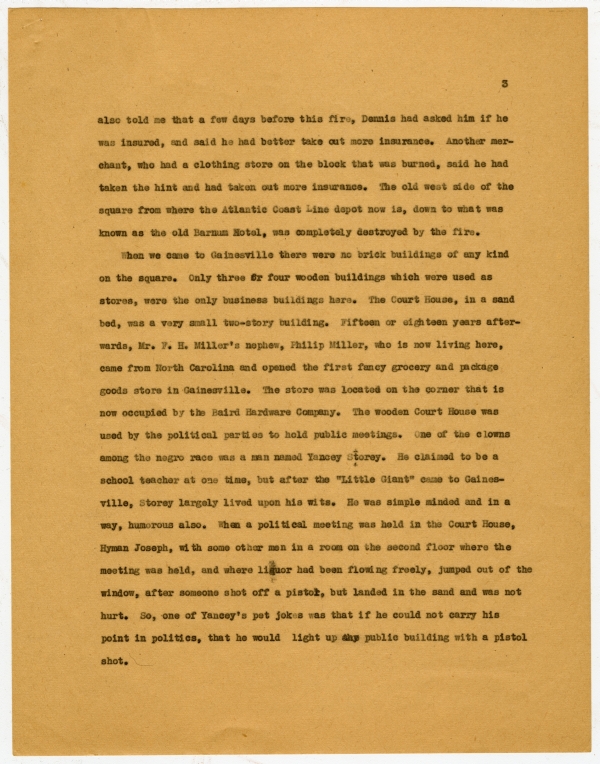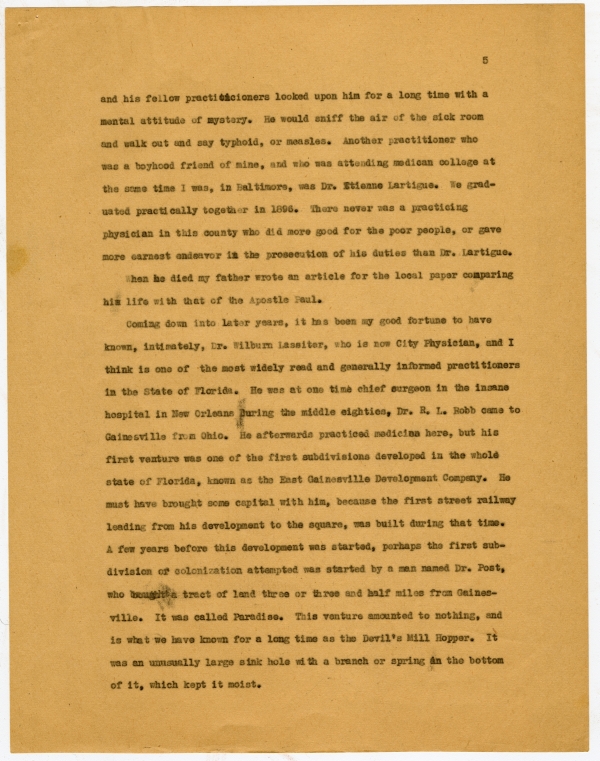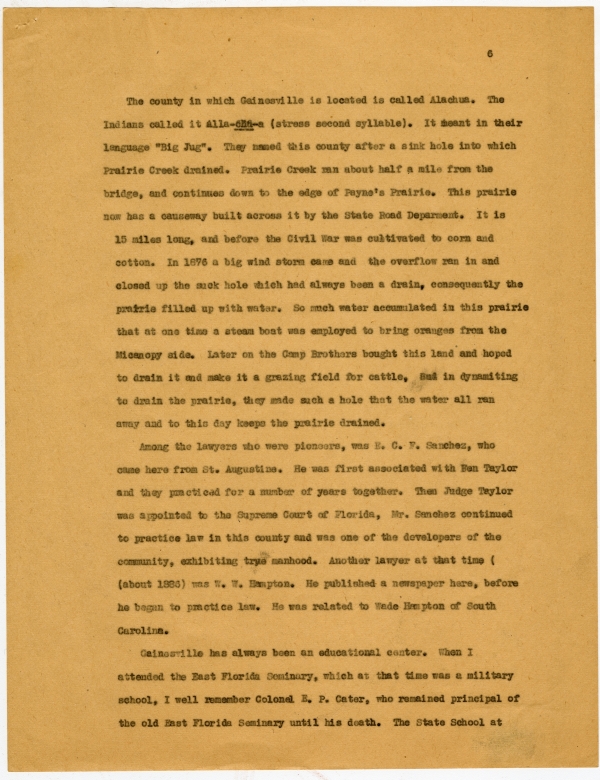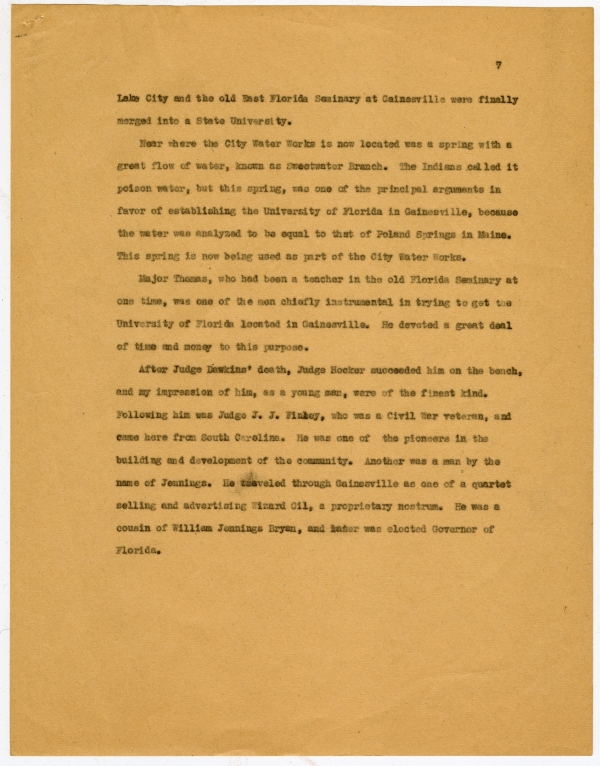Transcript
WPA
HISTORY OF ALACHUA COUNTY as told by Dr. J. Dawkins Tench, Nov. 9, 1936
During the fall of 1879 my father, Major John W. Tench, together with his wife and three small boys moved from Union County South Carolina to Gainesville. The turkey tracks had hardly been eliminated from the deep sand which made a portion of the little hamlet called Gainesville, Florida. Contrary to the usual opinion, Gainesville was not named after General Gaines, but was named following an election which was held between this section which is now known as Gainesville, and old Newnansville, for the settling of the question of which one should be the county seat of Alachua County. The present site of Gainesville won the election by a small majority, and on account of this fact was named Gainesville because it gaines [sic] the election over the Newnansville site.
We lived for one year in the home of Judge J. B. Dawkins, my mother's uncle. Judge Dawkins was at that time Juge of Circuit Court. One of the first impressions made, as a little boy, on me, was when we arrived at the Atlantic Coast Line depot we had one of those phaetons meet us, which had been sent by Judge Dawkins. It had two white horses hitched to a closed carriage. The next impression, which was somewhat subdued because of my mother's attitude forbidding me to go out to the orange trees, and which of course I did the very next morning, when I discovered the fruit was not ripe.
My father attended the University of Virginia when he was a young man. His purpose was to read law in the office of Judge Dawkins. Practicing with Judge Dawkins was Fenwick Taylor, brother-in-law of Judge Dawkins, who afterwards was one of the Supreme Court judges. Another brother-in-law of Judge Dawkin's was Jules Carlisle, who, soon after we came to Gainesville, became County Clerk of the Court.
2
During these troublesome times in Gainesville, which some people call the carpet baggers's regime, there came to Gainesville from somewhere north of here, a man by the name of L. G. Dennis. I do not feel like calling him a republican because his behavior would be a disgrace to any republican of high minded politics. I think his name would be better called a mugwump. He was a menace to the community, inciting the negroes to rebellion and creating a great deal of social as well as political disturbance. He was called a little giant, as he was of small stature. He brought with him a man named Wallace, who acted as his bodyguard while he was here.
The first public building that attracted my attention as a boy, was the Old Arlington Hotel, which was located on what is now known as Woolworth's 10¢ Store Block, and was large enough to occupy the whole block. They had a billiard room, which was a new thing to me, and, of course, the bar room. This hotel did not pay, as few tourists came to Florida at that time, and finally it went into the hands of the Receiver. Later on it was acquired by L. G. Dennis, "The Little Giant". The town was developing then, to some extent. Mrs. F. X. Miller had a dry goods and milliner store on the southwest corner of the square, which was directly off the Arlington Hotel. My two brothers and I were picking strawberries one morning about half way between this hotel and the present location of the University of Florida. It was about eight o'clock, when we say a blaze from the Arlington, which told us that the hotel was being rapidly consumed by fire. Mr. F. X. Miller told me that he ran into the hotel to see what it was, and found on the second story that a mattress had been taken off the bed and thoroughly saturated with kerosene oil, and that he was certain, as he saw the oil still on the floor and the half consumed mattress, that it was the work of an incendiary. He
3
also told me that a few days before this fire, Dennis had asked him if he was insured, and said he had better take out more insurance. Another merchant, who had a clothing store on the block that was burned, said he had taken the hint and had taken out more insurance. The old west side of the square from where the Atlantic Coast Line depot now is, down to what was known as the old Barnum Hotel, was completely destroyed by the fire.
When we came to Gainesville there were no brick buildings of any kind on the square. Only three or four wooden buildings which were used as stores, were the only business buildings here. The Court House, in a sand bed, was a very small two-story building. Fifteen or eighteen years afterwards, Mr. F. H. Miller's nephew, Philip Miller, who is now living here, came from North Carolina and opened the first fancy grocery and package goods store in Gainesville. The store was located on the corner that is now occupied by the Baird Hardware Company. The wooden Court House was used by the political parties to hold public meetings. One of the clowns among the negro race was a man named Yancey Storey. He claimed to be a school teacher at one time, but after the "Little Giant" came to Gainesville, Storey largely lived upon his wits. He was simple minded and in a way, humorous also. When a political meeting was held in the Court House, Hyman Joseph, with some other men in a room on the second floor where the meeting was held, and where liquor had been flowing freely, jumped out of the window, after someone shot off a pistol, but landed in the sand and was not hurt. So, one of Yancey's pet jokes was that if he could not carry his point in politics, that he would light up any public building with a pistol shot.
4
The first sidewalks that were built in Gainesville were built by Major Cullen. He was one Army officer who thoroughly understood the negro race. He was a good officer. When the soldiers who were camped here, began to get restless, he asked one of the lumber men to furnish him with enough lumber to build a plank walk from the Seaboard Air Line depot to the square. Major Cullen remained in Gainesville after his company was disbanded. He married a Miss Beville, who was a resident of the county, and has an heir now living in Newberry, Steve Cullen. He helped build the section in which he lives, perpetuating the memory of his father's activities. The activities of the "Little Giant" had elected four negroes, the police force was then manned by negroes.
One of the early pioneers in this section was a hard-working benevolent person by the name of Dr. James F. McKinstry, a man much beloved by people, and by his patients, who came in contact with him. Dr. McKinstry was afterwards made Post Master under President Wilson's administration. With the modern help, in the way of X-Ray machines and the modern methods of diagnosing cases, practitioners of the present day do not appreciate the resources of those old time pioneers in medicine. Dr. McKinstry had come up in the school of experience, during the following the Civil War [sic]. The nearest surgeons of any note were to be found in Jacksonville, and upon one occasion Dr. McKinstry was called in consultation on the case of a boy about 15 years old, which developed into what is known as intersusseption [sic], the bowels were locked in such a way as to cut off circulation entirely, and the lad would have died in about 14 to 18 hours. Dr. McKinstry took the patient on his back and by engaging in an Indian War dance he jiggled and jostled the intestine into its normal position, thus saving the boy's life. Dr. McKinstry was often called in consultation to diagnose a case, where a diagnosis was needed,
5
and his fellow [practitioners] looked upon him for a long time with a mental attitude of mystery. He would sniff the air of the sick room and walk out and say typhoid, or measles. Another practitioner who was a boyhood friend of mine, and who was attending medican college at the same time I was, in Baltimore, was Dr. Etienne Lartigue. We graduated practically together in 1896. There never was a practicing physician in this county who did more good for the poor people, or gave more earnest endeavor in the prosecution of his duties than Dr. Lartigue.
When he died my father wrote an article for the local paper comparing his life with that of the Apostle Paul.
Coming down into later years, it has been my good fortune to have known, intimately, Dr. Wilburn Lassiter, who is now City Physician, and I think is one of the most widely read and generally informed practitioners in the State of Florida. He was at one time chief surgeon in the insane hospital in New Orleans[.] During the middle eighties, Dr. R. L. Robb came to Gainesville from Ohio. He afterwards practiced medicine here, but his first venture was one of the first subdivisions developed in the whole state of Florida, known as the East Gainesville Development Company. He must have brought some capital with him, because the first street railway leading from his development to the square, was built during that time. A few years before this development was started, perhaps the first subdivision or colonization attempted was started by a man named Dr. Post, who bought a tract of land three or three and half miles from Gainesville. It was called Paradise. This venture amounted to nothing, and is what we have known for a long time as the Devil's Mill Hopper. It was an unusually large sink hole with a branch or spring in the bottom of it, which kept it moist.
6
The county in which Gainesville is located is called Alachua. The Indians called it alla-chu-a (stress second syllable). It meant in their language "Big Jug". They named this county after a sink hole into which Prairie Creek drained. Prairie Creek ran about half a mile from the bridge, and continues down to the edge of Payne's Prairie. This prairie now has a causeway built across it by the State Road [Department]. It is 15 miles long, and before the Civil War was cultivated to corn and cotton. In 1876 a big wind storm came and the overflow ran in and closed up the suck hole which had always been a drain, consequently the prairie filled up with water. So much water accumulated in this prairie that at one time a steam boat was employed to bring oranges from the Micanopy side. Later on the Camp Brothers bought this land and hoped to drain it and make it a grazing field for cattle. But in dynamiting to drain the prairie, they made such a hole that the water all ran away and to this day keeps the prairie drained.
Among the lawyers who were pioneers, was E. C. F. Sanchez, who came here from St. Augustine. He was first associated with Ben Taylor and they practiced for a number of years together. Then Judge Taylor was appointed to the Supreme Court of Florida, Mr. Sanchez continued to practice law in this county and was one of the developers of the community, exhibiting true manhood. Another lawyer at that time (about 1885) was W. W. Hampton. He published a newspaper here, before he began to practice law. He was related to Wade Hampton of South Carolina.
Gainesville has always been an educational center. When I attended the East Florida Seminary, which at that time was a military school, I well remember Colonel E. P. Cater, who remained principal of the old East Florida Seminary until his death. The State School at
7
Lake City and the old East Florida Seminary at Gainesville were finally merged into a State University.
Near where the City Water Works is now located was a spring with a great flow of water, known as Sweetwater Branch. The Indians called it poison water, but this spring, was one of the principal arguments in favor of establishing the University of Florida in Gainesville, because the water was analyzed to be equal to that of Poland Springs in Maine. This spring is now being used as part of the City Water Works.
Major Thomas, who had been a teacher in the old Florida Seminary at one time, was one of the men chiefly instrumental in trying to get the University of Florida located in Gainesville. He devoted a great deal of time and money to this purpose.
After Judge Dawkins' death, Judge Hocker succeeded him on the bench, and my impression of him, as a young man, were [sic] of the finest kind. Following him was Judge J. J. Finley, who was a Civil War veteran, and came here from South Carolina. He was one of the pioneers in the building and development of the community. Another was a man by the name of Jennings. He traveled through Gainesville as one of a quartet selling and advertising Wizard Oil, a proprietary nostrum. He was a cousin of William Jennings Bryan, and later was elected Governor of Florida.

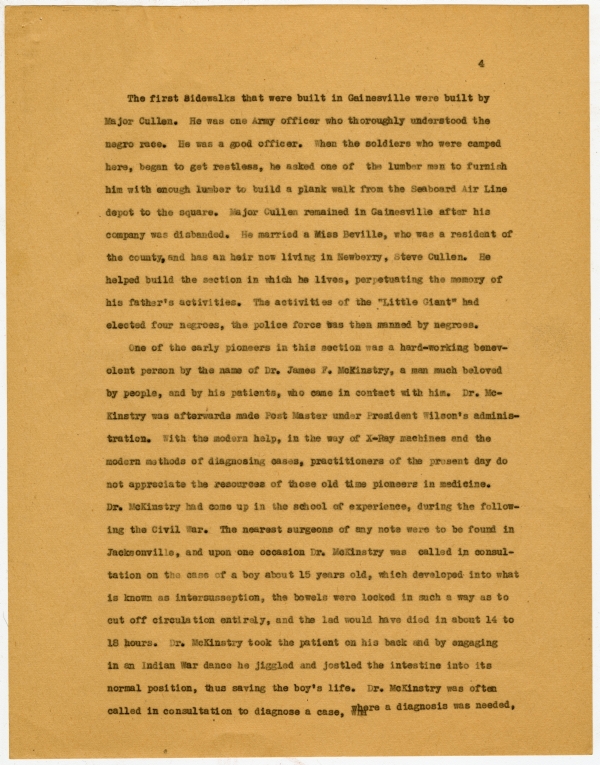


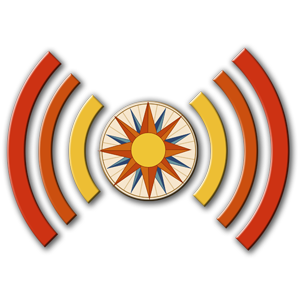 Listen: The Bluegrass & Old-Time Program
Listen: The Bluegrass & Old-Time Program